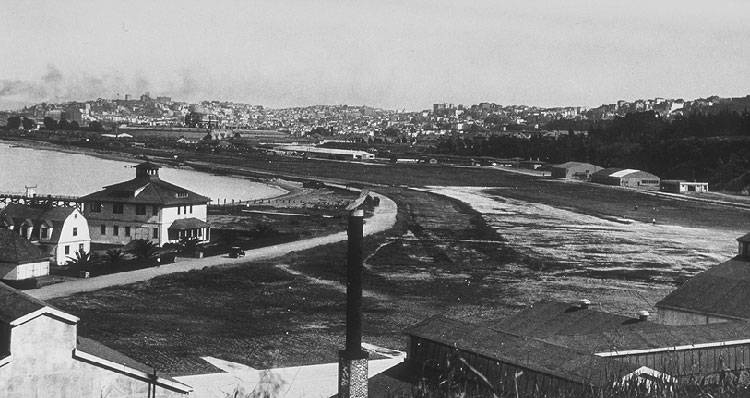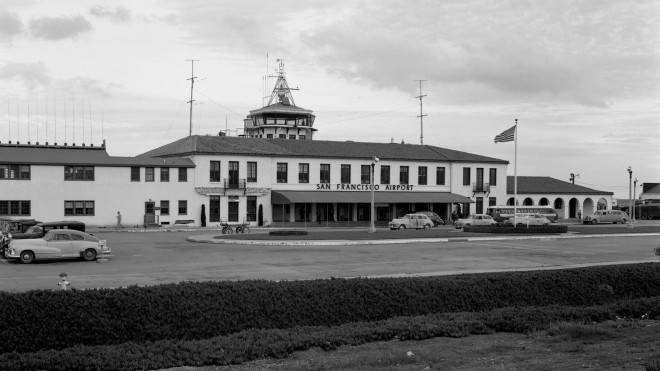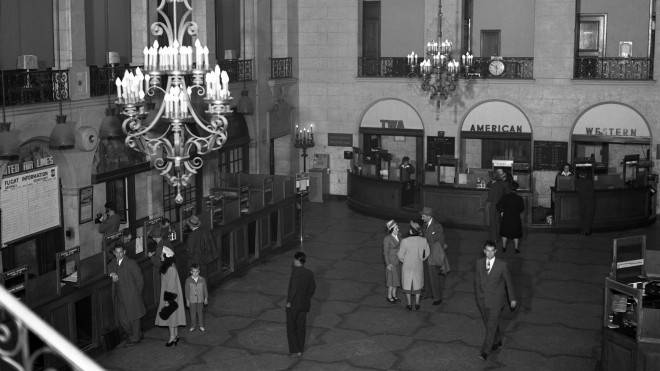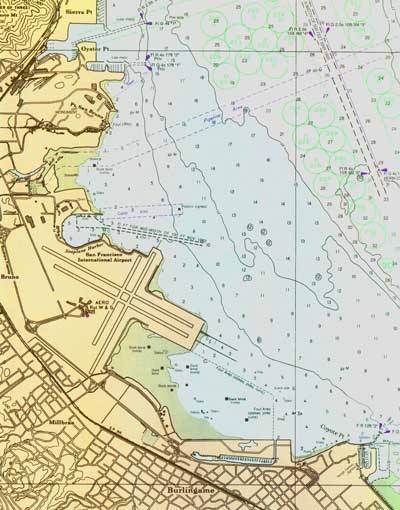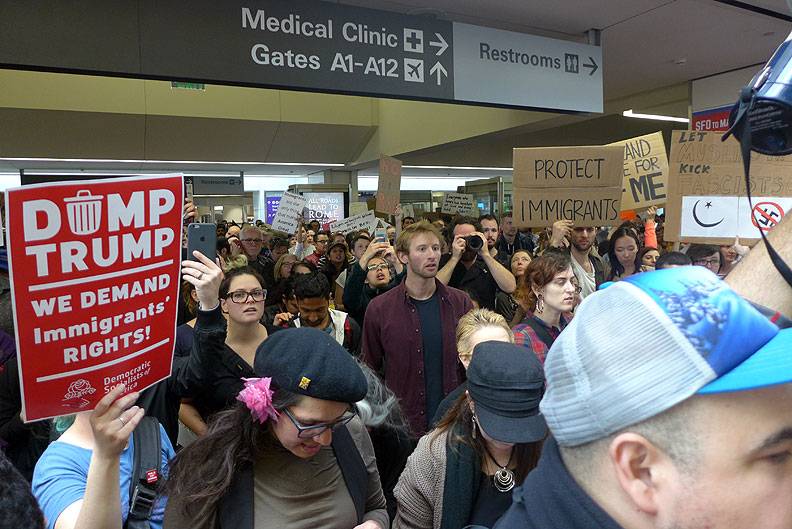San Francisco Airport: Difference between revisions
(added image) |
(added photos) |
||
| Line 165: | Line 165: | ||
''Video: Shaping San Francisco'' | ''Video: Shaping San Francisco'' | ||
[[Image:SFO-early-1960s sfm001-01221.jpg]] | |||
'''SFO, early 1960s.''' | |||
''Photo: SFMemory.org'' | |||
[[Image:Butler-Aviation-Operations-1950s sfm005-10861.jpg]] | |||
'''Butler Aviation Operations, 1960s.''' | |||
''Photo: SFMemory.org'' | |||
[[Image:SFO-PAA-sfm001-01222.jpg]] | |||
'''SFO, early 1960s.''' | |||
''Photo: SFMemory.org'' | |||
[[A UFO Blimp-napping over Daly City? August 16th, 1942 |Prev. Document]] [[Mills Field |Next Document]] | [[A UFO Blimp-napping over Daly City? August 16th, 1942 |Prev. Document]] [[Mills Field |Next Document]] | ||
[[category:San Francisco outside the city]] [[category:1910s]] [[category:1920s]] [[category:1930s]] [[category: | [[category:Transit]] [[category:San Francisco outside the city]] [[category:1910s]] [[category:1920s]] [[category:1930s]] [[category:1960s]] [[category:1970s]] [[category:1990s]] [[category:2010s]] [[category:2020s]] [[category:dissent]] [[category:South Bay and Peninsula]] | ||
Latest revision as of 20:45, 18 February 2024
Historical Essay
by Chris Carlsson
<iframe src="https://archive.org/embed/sf-airport-1941-and-clipper-cove-from-lost-landscapes-no-1" width="640" height="480" frameborder="0" webkitallowfullscreen="true" mozallowfullscreen="true" allowfullscreen></iframe>
Footage from SFO in 1941, followed by images of the PanAm Clipper circling around in Clipper Cove off Treasure Island.
Video: from "Lost Landscapes #1, 2007" courtesy Prelinger Archives
China Clipper at Treasure island in 1939.
Photo: Private Collection, San Francisco, CA
In 1915, San Franciscans were thrilled and then horrified by the aerial acrobatics of Lincoln Beachey as he did stunts over the bay as part of the Panama-Pacific International Exposition—until plunging to his death during a failed trick. Just west of the Exposition grounds was the city’s first airfield, a military post on Crissy Field in the Presidio.
Crissy Field in the 1920s.
Photo: Private Collection, San Francisco, CA
Commercial air traffic was still a couple of decades away. For a brief time it was projected that Treasure Island, built originally for the Golden Gate International Exposition in 1939-40, would be converted to an airport after the World’s Fair. The China Clipper was based on newly built Treasure Island in 1939. But when WWII interceded, Treasure Island became a naval base with navy taking over the original terminal building and the hangars.
Plans were floated in the 1920s to build an airfield in India Basin over the Islais Creek marshes.
1928 view of proposed China Basin airport by J.R. Miller and Timothy Pflueger.
Image: courtesy SF Museum of Modern Art
Eventually, the city of San Francisco purchased the tidelands at the eastern edge of the Darius Ogden Mills estate (which was eventually subdivided and became the town of Millbrae) in San Mateo county, and there opened the airport as Mills Field in the late 1920s. On June 9, 1931, the name was changed to San Francisco airport and was soon added to the purview of the City’s Public Utilities Commission.
Mills Field, 1928.
Photo: courtesy San Francisco Airport Museums
Mills Field Municipal Airport of San Francisco, c. 1929.
Photo: courtesy San Francisco Airport Museums
In the early 1930s, 350 acres of tidelands was “reclaimed” and by 1935, the airport had extended its runway C from 1,900 feet to 3,000 feet.
San Francisco Airport, 1935.
Photo: courtesy San Francisco Airport Museums
Passengers board a United Airlines Douglas DC-3, 1938.
Photo: courtesy San Francisco Airport Museums
The airport construction also created a basin for the amphibious planes that were still a common part of early air travel. Pan American chose the San Francisco Airport as its location to do the first regularly scheduled trans-oceanic air service. The flight took off from the San Francisco airport and 59 hours later, after four stops, it landed in Manila, Philippines. The plane was so heavy that when it took off from the airport it had to fly under the cables of the East Bay Bridge that had not been completed yet. The plane, China Clipper, became instantly famous and set off a rage of new toys, beer and food all with the name China Clipper.
San Francisco Airport, 1939. A 9000-foot seawall defined the new seaplane harbor and provided a 315 acre extension of the airport.
Photo: courtesy San Francisco Airport Museums
Pan American Airways Boeing 314 flying boats moored at SF Airport, 1946.
Photo: courtesy San Francisco Airport Museums
After WWII, the rechristened San Francisco International Airport (SFO) began its inexorable expansion, with a new terminal building, a new control tower, and expanded runways all taking shape.
San Francisco Airport curbside entrance, 1948.
Photo: courtesy San Francisco Airport Museums
Lobby and ticket counter at SF Airport, 1948.
Photo: courtesy San Francisco Airport Museums
Nearly completed new terminal at SF International Airport, 1954.
Photo: courtesy San Francisco Airport Museums
Passenger lobby at San Francisco International Airport, 1954.
Photo: courtesy San Francisco Airport Museums
Open house at the San Francisco Airport, August 28, 1954.
Photo: OpenSFHistory.org wnp010.10117
San Francisco International Airport, 1959.
Photo: courtesy San Francisco Airport Museums
In the late 1990s during the first Dotcom tech boom, SFO became the nation’s 9th busiest airport. SFO found itself confronted with chronic delays, which were blamed on the old mid-century runways, no longer separated enough to accommodate a higher flow of airline traffic. Mayor Willie Brown, the consummate deal-maker, embarked on a campaign to build new runways into San Francisco Bay in order to allow expansion of the airport. But strong opposition by Supervisor Aaron Peskin and a panoply of local environmental groups, plus the Bay Conservation and Development Commission, ultimately derailed the plans. Air traffic has fallen considerably since those booming times, and SFO now ranks 21st in airport business. Oakland and San Jose airports have also taken up some of the pressure on SFO.
Existing runway configuration at SFO.
Expansion plans as laid out by Mayor Willie Brown in the 1990s, defeated by environmental and political opposition.
In the early 2000s the city-owned facility completed its most recent expansion, adding a dedicated International Terminal, as well as building a 6-mile automated shuttle train system, and running an extension of the BART train system directly to the airport.
San Francisco International Airport is a bastion of union labor in the Bay Area. Nearly everyone working there belongs to one of over a dozen unions associated with the airline business, from machinists and pilots to flight attendants and custodial workers at the airport. Still, in 1981 the Professional Air Traffic Controllers Organization (PATCO) went on strike at the beginning of the Reagan Administration, and threw up a picket line at SFO. They were all fired by the government which sought to make an example of them to intimidate organized labor more generally. Their union was destroyed after a few months and a lack of solidarity from other airport unions.
After the 9/11 terror attacks in New York and Washington DC a radically ramped up security system was put in at SFO as at all airports nationwide. It was no longer enough to pass through the metal detectors that had existed for years. Now a whole theater of police state “security” had to be performed, from taking off shoes, hats, belts, and jackets, to removing everything from pockets, prohibiting all containers of liquid, and so on, all while standing in long, slow-moving lines. (Since 2017 the government has begun offering frequent travelers a way to get pre-checked and avoid some of the worst of the humiliating and pointless Transportation Security Administration rituals.) The absurd system of color-coded warnings implemented by the ominously named “Department of Homeland Security” quickly became a meaningless joke. Repeated breaches of the security system at most airports underscores the reality that the whole system is designed to teach-and-test docility and obedience to the average traveler and has very little to do with anything that might be called “public safety.”
In January 2017, the incoming Trump administration promulgated draconian new rules to prevent immigration by Muslims, even banning green-card holders and people already holding valid visas and en route to U.S. airports. Thousands of people quickly besieged airports around the country, including SFO. For several days prior to a federal court judge reversing the ban (something that would happen twice more in the year), thousands of Bay Area residents marched, sang, chanted, and occupied the lobby of the International Terminal in a stirring rebuke to the xenophobia and racism that had taken over the government.
Protests against the Trump Muslim ban rocked SFO in January 2017.
Photo: Chris Carlsson
Photo: Chris Carlsson
SF International Airport 2009.
Photo: LisaRuth Elliott
SFO, 2015.
Photo: Chris Carlsson
PSA stewardesses in the 1970s during the height of sexist advertising campaigns of the era, before the gender integration of the field and the renaming of the job "flight attendant.."
Image via Kim Lee, Facebook
<iframe src="https://archive.org/embed/peoples-history-of-sfo-eric-porter-nov-8-2023" width="640" height="480" frameborder="0" webkitallowfullscreen="true" mozallowfullscreen="true" allowfullscreen></iframe>
Eric Porter, author of the recent A People’s History of SFO, gives a deep look at SFO—San Francisco International Airport—which has come a long way from its muddy beginnings as Mills Field in the 1920s. Functioning as the center of the Bay Area’s modernizing transportation networks, SFO’s evolution illuminates fraught questions of access and employment discrimination, while becoming an “infrastructural manifestation of a succession of regional colonial presents, layered on top of sinking concrete, steel, and landfill upon mud.” And today’s airport, with rising bay waters lapping at its shores, confronts us with the implacable role of air travel in climate change, which no amount of berms and protective seawalls will solve.
Video: Shaping San Francisco
SFO, early 1960s.
Photo: SFMemory.org
Butler Aviation Operations, 1960s.
Photo: SFMemory.org
SFO, early 1960s.
Photo: SFMemory.org


